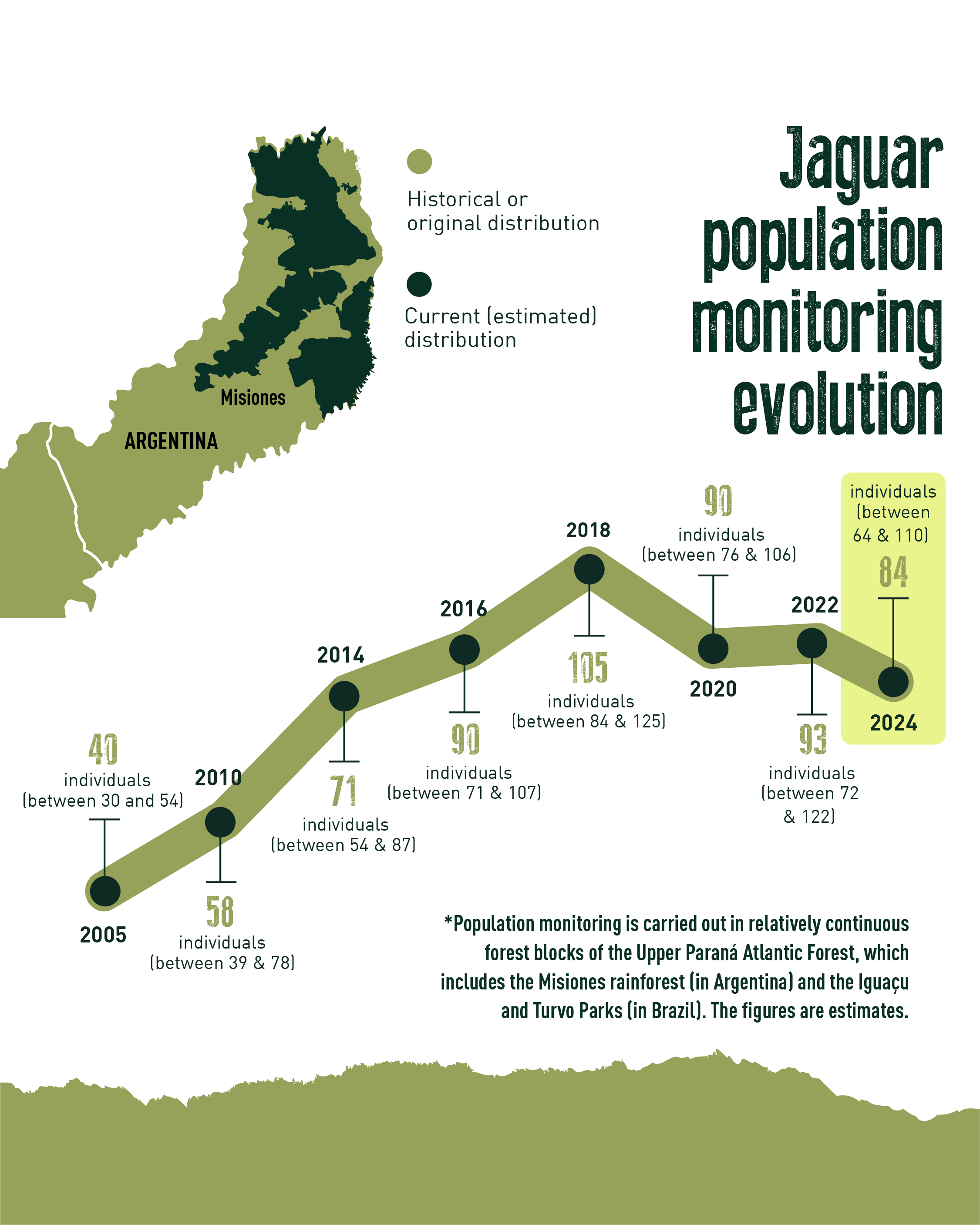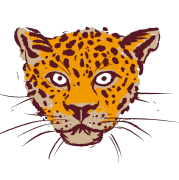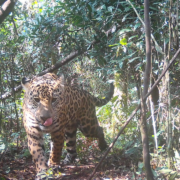Between 64 and 110 jaguars remain in the Atlantic Forest, with an estimated average of 84 individuals. This data comes from the most recent binational population monitoring study conducted in Argentina and Brazil. The figures show a slight decline compared to previous years, after a period of steady growth and population stability.
The announcement was made this afternoon in Posadas by Fundación Vida Silvestre Argentina and CONICET researchers of Proyecto Yaguareté (CeIBA – CONICET), during the regular meeting of the Management Committee of the National Conservation Plan for the Jaguar (Panthera onca), Argentina’s national natural monument. For both organizations, which have worked for over 20 years to conserve the species, the results are a warning signal regarding the long-term sustainability of Argentina’s largest wild cat.
“The jaguar is a key indicator of ecosystem health. This slight decrease reflects growing pressure on our ecosystems. It’s crucial that authorities and society as a whole renew their commitment to jaguar conservation,” stated Lucía Lazzari, Forest Program Coordinator at Fundación Vida Silvestre Argentina. “Strengthening efforts in protected areas in Misiones —particularly addressing poaching and conflict between jaguars and domestic animals— is now essential to prevent this situation from worsening. Provincial and national parks need more funding and attention from authorities,” she added.
Agustín Paviolo, CONICET independent researcher and leader of the Proyecto Yaguareté, noted: “Between 2006 and 2018, thanks to coordinated efforts by government agencies, NGOs, and scientists, we managed to double the jaguar population in Misiones. However, these new estimates show that we cannot reduce resources and efforts, or we risk losing all the progress we’ve made.”
Population monitoring began in 2003, when only about 40 jaguars remained. Since then, thanks to conservation actions, territorial management, communications, and environmental education, the population doubled and stabilized. However, current results show the situation remains fragile and demands stronger, sustained responses. Despite this slight drop, Misiones still hosts Argentina’s largest jaguar population.
Poaching (which is illegal and punishable by law in Misiones), human-jaguar conflict in rural areas near protected zones, roadkill from highways cutting through forested areas, and forest loss and fragmentation are the main threats facing the jaguar. In Argentina, the species is classified as critically endangered.
Jaguar: a species under threat
Between 1990 and 1995, an estimated 400–800 jaguars roamed the Upper Paraná Atlantic Forest, which includes the Misiones rainforest and Brazil’s Iguaçu National Park. By 2005, that number had plummeted to just 40 individuals, bringing the species to the brink of extinction.
Since then, government agencies, NGOs, and scientists have worked together on the Jaguar Conservation Action Plan —a coordinated framework to preserve the species in Misiones.
Since 2003, consistent population monitoring has been maintained, and over time, the number of jaguars doubled. In 2018, the population was estimated at 105 individuals. After a few years of stability, the latest estimates now show a slight decline.
Who conducts the jaguar monitoring and how?
The study is led by scientists from the Instituto de Biología Subtropical (UNAM – CONICET) through Proyecto Yaguareté (CeIBA – CONICET) in Argentina and the Onças do Iguaçu Project (ICMBio – Brazil), with support from numerous institutions. The population estimate covers the largest remaining tract of the Upper Paraná Atlantic Forest: the Misiones rainforest, Iguaçu National Park, and Turvo State Park in Brazil. This binational initiative has taken place every two years for over two decades, supported by Fundación Vida Silvestre Argentina, WWF-Brazil, and other organizations.
The survey is based on the analysis of images from camera traps —motion-activated cameras placed in specific locations across the study area. When an animal walks by, the camera takes a photo or video. These images allow scientists to track the presence of various species and assess the forest’s health. Each jaguar is identified by its unique spot pattern, much like a human fingerprint.
Researchers then apply mathematical models to estimate a population’s minimum and maximum number of individuals within a given area. Since it’s impossible to count every animal, these ranges account for the uncertainty inherent in this type of study, while enabling long-term population monitoring.
The 2024 monitoring effort covered over 570,000 hectares across both countries, with 267 camera trap stations placed at strategic points —an area approximately 27 times the size of Buenos Aires.
Why Jaguar conservation matters?
The jaguar (Panthera onca) is the largest cat in the Americas and the third largest in the world, after the lion and the tiger. In Argentina, it is critically endangered due to habitat loss, roadkill, and illegal hunting of both the jaguar and its prey.
Protecting jaguars is about much more than conserving a single species —it’s about preserving healthy forests, carbon reserves, biodiversity, water availability, and cultural and natural heritage. Conservation efforts also support economic opportunities for local communities and contribute to climate change mitigation and adaptation.
Jaguars without borders: the importance of biodiversity corridors
Jaguar population monitoring has long been coordinated between Argentina and Brazil. This reflects a clear ecological reality: the wildlife of the Upper Paraná Atlantic Forest —the Misiones rainforest— doesn’t recognize political borders and relies on the continuous forest habitat shared by both countries.
This connectivity allows individual jaguars to be detected in both Argentina and Brazil, highlighting the importance of maintaining and restoring biodiversity corridors and reinforcing binational cooperation to protect the species.
The unique spot pattern on each jaguar enables researchers to identify and follow individual animals. Several have become iconic:
Hendú, a male first identified in Argentina’s Iguazú National Park in 2020, was recorded in Brazil in 2024. With the support of both countries’ research teams, he was fitted with a satellite collar, allowing real-time tracking as he returned to Argentina.
Kunumi, a female also fitted with a satellite collar, crossed the Iguazú River and was spotted in high-traffic tourist areas, including the falls. She was even photographed from a boat tour, showcasing the coexistence of wildlife and human activity.
Perí, a young male born in Brazil, was photographed for the first time in Argentina’s San Jorge Forest Reserve, south of Iguazú National Park —showcasing significant dispersal in search of territory.
Other well-known jaguars like Araucano, a large male who frequently crosses the border, and Urupé, first spotted in Brazil and later photographed in Argentina, are also part of this growing dataset.
These cases clearly show that jaguars depend on landscape connectivity for survival. The Green Corridor of Misiones and its link with Brazil’s protected areas are essential to ensuring the future of this endangered species.
Data from camera traps and satellite collars not only reveal the life stories of these big cats but also provide crucial input for designing effective regional conservation strategies.
Protecting corridors means protecting the entire Atlantic Forest ecosystem.

About Fundación Vida Silvestre Argentina
Fundación Vida Silvestre Argentina is a non-governmental, non-profit public-interest organization founded in 1977. Its mission is to propose and implement solutions to conserve nature, promote the sustainable use of natural resources, and foster responsible behavior in the context of climate change. Since 1988, it has been the Argentine associate of WWF, one of the world’s largest independent conservation organizations, present in over 100 countries.
More info: www.vidasilvestre.org.ar
Media contact:
Lorena Papalardo | Communications Analyst


